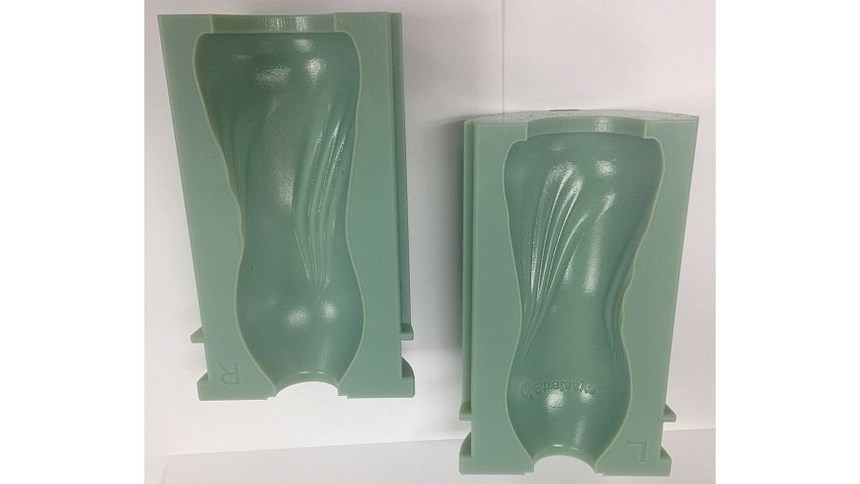Where Do 3D-Printed Molds Make Sense?
Stratasys describes the capabilities and limitations of 3D “digital ABS” molds for making plastic parts through injection molding or blow molding.
Share
Read Next
Is it possible to mold a plastic part using mold tooling that is also made of plastic? 3D printing technology provider Stratasys says this is not only possible, but preferable in some cases. These photos show examples of 3D-printed “digital ABS” tooling, which is used for both injection molding and blow molding.
The mold tooling material is produced on a Stratasys Connex 3D printer. This printer digitally creates combination materials by rapidly laying down tiny dots of different materials as it builds the part. To create mold tooling, it combines a heat-resistant plastic with a matrix engineered for high strength. The result is a material that can withstand both the high pressure and high temperature of a molding cycle. The mold tooling material is in fact one of the very strongest materials created on the Connex 3D printer, which is more frequently used to make multi-material prototype parts.
Stratasys sales manager Nadav Sella has been involved in the development of this machine’s application to mold tooling ever since an end user of the machine first hit on the idea of making molds this way nearly 5 years ago. He says the life of one of these digital ABS tools is heavily influenced by both the material being molded and the geometry of the part. On a six-cavity injection mold making ice cream spoons in polypropylene, he says the digital ABS mold delivered 600 spoons. By contrast, for more complex geometries using reinforced nylon, the tool might deliver 20 injected parts. In general, where tooling is needed for low quantities or for an initial run of parts, quickly 3D printing a mold can both save cost and speed the time to market, he says.
There are limitations. He and others within Stratasys have worked through a number of applications of digital ABS molds, and this has allowed them to develop a set of best practices that they share with users. That set of best practices keeps improving as digital ABS tooling is applied to more geometries and materials, he says, but the key is to respect the mechanical and physical properties of the tool. Heat conductivity is not like that of aluminum or tool steel, leading to tool design considerations aimed at avoiding heat concentration. One example concerns gate size and type; point gates, cashew gates and banana gates should be avoided.
Precision is also a consideration. The 3D printer is precise, but not as precise as a CNC machine tool. Thus, it can’t produce molds with the finest features, such as the tight-tolerance details of some electronics-industry molds. Also, to ensure the accuracy needed for precise seating of ejector pins, these holes should be 3D printed undersize, then reamed to achieve an accurate diameter.
“This is a different material,” he says. Established moldmaking professionals are accustomed to molds being made from metal. Compared to this, 3D printed tooling requires slight design and process changes. His advice to potential users is to expect to take some time getting used to what this option can do. However, “for the shop that does 100 molds per year—some in steel and some in aluminum—what if 10 or 20 of those molds could be 3D printed instead?” That portion is realistic, and could amount to considerable savings in cost and time.
Related Content
Large-Format “Cold” 3D Printing With Polypropylene and Polyethylene
Israeli startup Largix has developed a production solution that can 3D print PP and PE without melting them. Its first test? Custom tanks for chemical storage.
Read More8 Cool Parts From RAPID+TCT 2022: The Cool Parts Show #46
AM parts for applications from automotive to aircraft to furniture, in materials including ceramic, foam, metal and copper-coated polymer.
Read MoreHow to Build 10,000+ Shot Molds in Hours
Rapid tooling isn’t so rapid when it takes days to 3D print a metal mold, and then you still must machine it to reach the necessary tolerances. With Nexa3D’s polymer process you can print a mold in hours that is prototype or production ready and can last for more than 10,000 shots.
Read MoreThis Drone Bird with 3D Printed Parts Mimics a Peregrine Falcon: The Cool Parts Show #66
The Drone Bird Company has developed aircraft that mimic birds of prey to scare off problem birds. The drones feature 3D printed fuselages made by Parts on Demand from ALM materials.
Read MoreRead Next
3D Printing Brings Sustainability, Accessibility to Glass Manufacturing
Australian startup Maple Glass Printing has developed a process for extruding glass into artwork, lab implements and architectural elements. Along the way, the company has also found more efficient ways of recycling this material.
Read MoreHybrid Additive Manufacturing Machine Tools Continue to Make Gains (Includes Video)
The hybrid machine tool is an idea that continues to advance. Two important developments of recent years expand the possibilities for this platform.
Read MoreAt General Atomics, Do Unmanned Aerial Systems Reveal the Future of Aircraft Manufacturing?
The maker of the Predator and SkyGuardian remote aircraft can implement additive manufacturing more rapidly and widely than the makers of other types of planes. The role of 3D printing in current and future UAS components hints at how far AM can go to save cost and time in aircraft production and design.
Read More


















